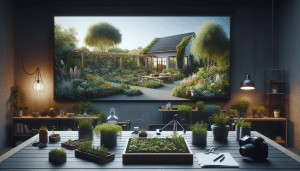You Can Design a Low Maintenance Garden
Daniel Fisher September 2, 2025
Curious about transforming your space into a thriving oasis with minimal effort? Discover actionable insights on designing a low maintenance garden that saves water, reduces chores, and creates year-round beauty. This guide reveals clever techniques to achieve stunning outdoor results, no matter your gardening experience.
Understanding Low Maintenance Garden Principles
Low maintenance gardens are becoming popular as more people seek outdoor spaces that offer beauty without nonstop work. The secret lies in a creative blend of smart plant selection, organized layouts, and practical groundcover strategies, which together minimize gardening chores. Selecting the right plants means less weeding, fewer pest concerns, and greater energy savings, while groundcovers help suppress unwanted growth and bring unity to your garden’s overall design. The appeal isn’t only about less time spent on labor; it’s about cultivating a serene, inviting environment that supports relaxation and healthy living at home. Learn more about the fundamental ideas that shape modern, low maintenance garden approaches and why they matter for busy families or anyone seeking a lush getaway with less effort.
Design starts well before planting. Professionals recommend grouping plants with similar water and sunlight needs, also known as hydrozoning, to simplify irrigation and support plant health. This approach helps prevent plant stress and makes garden tasks like mulching or pruning easier to manage. A well-thought-out plan considers pathways, borders, and focal points so that every section receives proper attention without feeling overwhelming. Subtle changes, such as swapping out resource-heavy lawns for drought-tolerant alternatives, can make an immediate impact. Some even find the process of initial planning relaxing—an enjoyable precursor to reaping the ongoing rewards of a carefully designed garden. For many, this marks the foundation for years of enjoyment.
Environmental benefits emerge as a major bonus. Low maintenance gardens frequently conserve water, lower chemical use, and create a welcoming environment for pollinators and helpful insects. Since such gardens need less mowing, watering, and spraying, they align with sustainable living goals and allow homeowners to cut back on utility bills while spending quality time outdoors. Local wildlife—birds, bees, butterflies—quickly find a haven in thoughtfully planted spaces, which often require less care than traditional lookalike lawns. The outcome is a self-sustaining outdoor area offering peace of mind and lasting value to both people and the planet. With little input, the results can surprise and delight season after season. https://www.rhs.org.uk/advice/profile?pid=1012
Selecting the Most Resilient Plants
Choosing the best low maintenance plants is fundamental for a successful garden makeover. Drought-tolerant perennials, ornamental grasses, succulents, and native shrubs work especially well. Native plants, in particular, adapt to the existing climate and need less watering and feeding, which means they settle in much faster and resist local pests. When matched to their environment, these plants create a living tapestry that rarely needs intervention. A diverse palette—with flowering groundcovers, evergreen textures, and layered heights—keeps interest high year-round while requiring minimal replanting or attention. Many gardening experts suggest consulting local master gardener programs or cooperative extension services for curated lists tailored to your microclimate and soil type. That advice can help eliminate costly trial and error by pointing to what truly thrives with little maintenance.
Some widely recognized garden staples include lavender, Russian sage, sedum, yarrow, and coneflower—icons of drought resistance and consistent beauty. Mediterranean herbs such as rosemary and thyme offer a dual-purpose solution; they stay visually pleasing and supply fresh seasoning for the kitchen, making them favorites for busy home cooks. Choosing resilient varieties like these reduces the risk of losing plants during weather swings or dry spells. Additionally, tough ornamental grasses add movement and grace while crowding out weeds. With so many attractive options, even new gardeners can build a robust, low maintenance plant collection that suits both climatic needs and design goals. This flexibility supports creativity while minimizing the demands on daily routines.
Planting with intention isn’t just practical—it’s rewarding. Gardeners often discover a new sense of connection to nature when observing how resilient plants adapt to their conditions. Using mulches or gravel around base plantings further simplifies weed management and preserves soil. Even small-scale vertical gardens or container displays can follow these principles, offering options for limited spaces or balconies. The overall experience fosters curiosity and long-term satisfaction, as every carefully chosen plant adds another layer of ease to the garden’s management. Low maintenance need not mean boring; the right mix delivers an inspiring, ever-evolving canvas you’ll appreciate more as time goes on. https://www.gardeners.com/how-to/designing-a-low-maintenance-garden/8701.html
Mastering Water-wise Gardening Techniques
Wise water use lies at the core of every low maintenance garden. Simple strategies such as drip irrigation, rainwater harvesting, and deep mulching can radically reduce the time and resources spent on watering. Drip irrigation systems, in particular, deliver water slowly to plant roots while minimizing waste from evaporation. Mulches—like bark chips or shredded leaves—keep soils moist and cool, cut down on weeds, and improve soil fertility as they break down. Pairing these solutions with plant groupings based on moisture requirements makes for an efficient and sustainable setup. Many gardeners are surprised at how quickly these changes pay off—scheduling, cost, and environmental savings multiply with every season. Combining techniques also fosters a sense of stewardship that extends beyond the property line, inspiring greater awareness of resource use across daily life.
Many designers encourage rain gardens, which channel runoff from roofs and drives toward thirsty perennial beds or infiltration zones. These spaces filter and absorb water, helping prevent local flooding and supporting pollinators at the same time. Rain barrels offer an affordable, beginner-friendly way to capture roof runoff for use during dry periods, and DIY kits can be installed in a weekend. With climate variability bringing new weather extremes, these small improvements position gardens for greater resilience. Implementing them leads to fewer replacement costs and cultivates an outdoor space that is both practical and beautiful. Wise watering is as much about prevention as it is about efficiency—the trick is prioritizing long-term sustainability over short-term fixes.
Efficiency does not mean deprivation. Strategic watering supports lush plantings, yet frees up time and reduces the strain on local water supplies. The cumulative effect—when combined with gravel paths, drought-proof foliage, and creative mulching—is a robust, climate-proof garden. These lessons aren’t reserved for experts. Anyone, regardless of experience, can experiment with simple enhancements that save water and labor. Dig deeper into water-wise gardening to empower your landscape with sustainable habits that yield comfort for years to come. https://www.epa.gov/watersense/water-efficient-landscaping-tips
Innovative Design Ideas for Lasting Beauty
Creativity can elevate a low maintenance landscape, proving that practicality and style belong together. Incorporating winding paths, layered garden beds, and statement features like boulders, dry streams, or raised planters brings structure and visual appeal to even the simplest layouts. Well-placed benches and birdbaths invite relaxation, while naturalistic plant groupings mimic wild meadows, cutting back on repetitive chores like pruning or mowing. The effect is a garden that welcomes exploration and delivers beauty in every season. Blending artistic touches with eco-friendly design simplifies care, letting each element serve multiple purposes.
Containers and vertical gardens present exciting options for those with small spaces or hardscaped yards. Self-watering containers and slow-release fertilizers minimize the need for frequent tending. Raised beds improve drainage and make plant care more accessible—plus they help control soil composition. Mixing perennial groundcovers with strategically placed evergreens supplies structure, color, and texture without demanding frequent replanting. Experimenting with layers and repetitions can guide the eye along natural curves or toward favorite spots in the yard. This approach results in a cohesive, inviting space where maintenance takes a back seat to enjoyment.
Lighting and garden art add finishing touches, extending outdoor enjoyment into the evening hours. Solar-powered lanterns, for example, require no wiring and create ambiance while supporting energy conservation. Weather-resistant sculptures or artfully arranged stones provide interest even when flowers fade. With careful design, a low maintenance garden evolves with every change of season, offering evergreen appeal and the opportunity to grow alongside your landscape. The end result isn’t just a low maintenance yard—it’s a personalized retreat shaped by creativity, convenience, and nature’s own rhythms. https://extension.psu.edu/landscaping-with-low-maintenance-designs
Best Practices for Sustainable Low Maintenance Gardens
Maintaining a low maintenance garden is about working smarter, not harder. Routine practices—like applying organic mulch, leaving grass clippings on lawns, and letting beneficial insects thrive—reduce chores while nurturing soil health. Composting yard waste is one powerful way to recycle nutrients, cutting down on the need for synthetic fertilizers. Recognizing the growth habits of chosen plants makes pruning or thinning a seasonal task, not a constant struggle. Even a short weekly walk through the garden can reveal needs before they grow into big issues. Sustainable routines make gardening a pleasure instead of a burden, keeping your efforts manageable and rewarding.
Many successful gardeners embrace “right plant, right place,” ensuring every addition is well-suited to its sun, soil, and moisture conditions. Allowing plants to naturalize, or spread at their own pace, gives the garden a lived-in look while filling empty spaces and reducing weeding. Planting in layers—tall trees, mid-size shrubs, low perennials—creates shade and prevents soil erosion, reducing the need for irrigation and extra maintenance. These straightforward methods form the backbone of beautiful, hassle-free gardens everywhere. Small habits compound over time, yielding a tapestry of low-maintenance charm that engages all the senses.
Learning from others and staying curious sustains progress. Extension services, public garden tours, and online community forums share tips for refining techniques and overcoming local challenges. Adapting proven ideas to local contexts ensures that your garden remains vibrant in changing conditions. Every season, new lessons emerge, adding depth to the experience and encouraging fresh experiments. With sustained attention to sustainable practices, every garden can become a refuge from daily stress and a showcase for resilient beauty. https://www.gardeningknowhow.com/garden-how-to/projects/how-to-create-a-low-maintenance-garden.htm
Getting Started: Smart Steps for Your First Low Maintenance Garden
Diving into the world of low maintenance gardening need not feel overwhelming. Start by taking stock of your yard’s conditions—sunlight, drainage, and existing vegetation—to pinpoint strengths and areas for improvement. Sketch a simple plan outlining zones for relaxation, plantings, and pathways, then map out the best spots for drought-tolerant or native species. Local garden centers often offer workshops on design basics, equipping beginners with knowledge about soil testing and microclimate considerations. With a little research, even first-time gardeners can avoid common pitfalls and set their projects up for success. This phase builds momentum and excitement, bringing dreams of a lush but low-maintenance sanctuary within easy reach.
Next, focus on manageable sections. Transforming one garden bed at a time curbs overwhelm and allows lessons to shape your growing style. Start small, experiment with plant combinations, try out mulches, and compare watering approaches to find what fits your routine. Many gardeners discover that patience is the secret ingredient—letting plants establish naturally leads to stronger, healthier landscapes. Celebrate every small milestone, and don’t be afraid to adapt as seasons pass and your needs change. Each decision you make now lays the groundwork for future simplicity and satisfaction.
Document progress by keeping notes, snapping photos, and participating in local gardening groups or online communities. Sharing your experience encourages others and opens up new sources of support and inspiration. The community aspect of low maintenance gardening goes far beyond DIY—it transforms yards into shared learning labs. As experience grows, you’ll recognize new opportunities to experiment and refine your approach, resulting in an outdoor space that truly feels personal and inviting. https://extension.umn.edu/lawn-care/creating-low-maintenance-lawns-and-landscapes
References
1. Royal Horticultural Society. (n.d.). Low maintenance gardening. Retrieved from https://www.rhs.org.uk/advice/profile?pid=1012
2. Gardener’s Supply Company. (n.d.). Designing a low-maintenance garden. Retrieved from https://www.gardeners.com/how-to/designing-a-low-maintenance-garden/8701.html
3. U.S. Environmental Protection Agency. (n.d.). Water-efficient landscaping tips. Retrieved from https://www.epa.gov/watersense/water-efficient-landscaping-tips
4. Penn State Extension. (n.d.). Landscaping with low-maintenance designs. Retrieved from https://extension.psu.edu/landscaping-with-low-maintenance-designs
5. Gardening Know How. (n.d.). How to create a low-maintenance garden. Retrieved from https://www.gardeningknowhow.com/garden-how-to/projects/how-to-create-a-low-maintenance-garden.htm
6. University of Minnesota Extension. (n.d.). Creating low-maintenance lawns and landscapes. Retrieved from https://extension.umn.edu/lawn-care/creating-low-maintenance-lawns-and-landscapes








